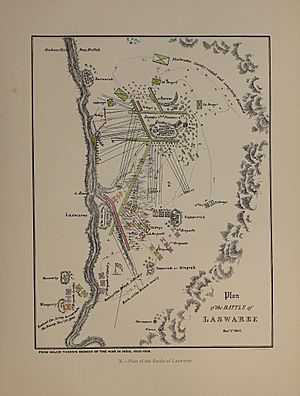Battle of Laswari facts for kids
Quick facts for kids Battle of Laswari |
|||||||
|---|---|---|---|---|---|---|---|
| Part of the Second Anglo-Maratha War | |||||||
 Plan of the battle of Laswaree |
|||||||
|
|||||||
| Belligerents | |||||||
| Commanders and leaders | |||||||
| Strength | |||||||
| 10,000 Plus an unknown no. of troops from Alwar |
9,000 Infantry 5,000 Cavalry |
||||||
| Casualties and losses | |||||||
| "slightly over 800" | around 7,000 killed | ||||||
The Battle of Laswari was an important fight that happened on November 1, 1803. It took place near a village called Laswari, in the Alwar area of India. This battle was a key part of the Second Anglo-Maratha War.
The British forces, led by General Lake, wanted to end the war. They aimed to defeat the last strong army of the Maratha confederacy. This Maratha army had twelve groups of trained foot soldiers. Their original leader, Chevalier Dudrenec, left them. Command then went to Ambaji Ingle, an experienced Maratha officer.
General Lake decided to move very quickly to catch the Maratha army. He first left behind his heavy cannons and then even his foot soldiers. Lake's cavalry (soldiers on horseback) first met the enemy. These British horsemen charged many times. They managed to hold back the Maratha Army until the British foot soldiers arrived.
Contents
Who Fought in the Battle?
The British army, led by General Lake, had about 10,000 soldiers. They were fighting against Sindhia's army. Sindhia's force had 9,000 experienced infantry (foot soldiers) and 5,000 cavalry (horse soldiers). This Maratha force was under the command of Ambaji Ingle. The British also had help from soldiers from Alwar.
The Fight at Laswari
The Maratha foot soldiers fought very bravely. They held their ground until the few who survived had to give up. The Maratha cavalry also suffered many losses. After the battle, the British captured 72 cannons. They also took a lot of ammunition and supplies.
General Lake later wrote about the battle. He said, "I never was in so severe a business in my life or anything like it… these fellows fought like devils, or rather like heroes." This shows how tough the fight was.
Both sides had many casualties (soldiers killed or wounded). The British East India Company lost many officers. These included Major General Weir, Colonel Vandeleur, and Major Griffith. General Lake's own son was also killed in the battle.
After the Battle
The Battle of Laswari was a big win for the British. On December 17, 1803, Raghuji Bhonsale (II) of Nagpur signed a peace agreement. This was called the Treaty of Deogaon. After this treaty, he gave the British the area of Cuttack, which included Balasore.
It is also said that people from the Meena tribe of Shahjahanpur fought hard in this battle. They helped push the British away.
Key Moments Leading to Laswari
After attacking and taking Aligarh on September 4, 1803, General Lake moved towards Delhi. There, the Marathas were again defeated in the Battle of Delhi. At the end of September, Lake left Delhi and marched to Agra. He captured the fort at Agra.
However, there were still fifteen groups of trained Maratha soldiers. These had been sent by Sindhia from the Deccan region. Their leader, Chevalier Dudrenec, gave himself up to the British. But his soldiers remained together. Two more groups who had escaped from Delhi joined them. This strong Maratha force did not try to stop Lake from taking Agra. Their main goal was to get Delhi back. Sindhia thought taking Delhi back was very important for his reputation.
General Lake marched west from Agra on October 27, 1803. He was going after this Maratha force. They were known to be near Kathumar. When Lake reached Kathumar on October 31, he learned the enemy had left that morning. They had moved north.
On October 29, Lake was joined by Ahmad Bakhsh Khan. He was a representative (called a Vakil) of the Alwar ruler. Ahmad Bakhsh Khan brought soldiers and a group of Meos. They helped a lot by providing supplies and information about where the Marathas were moving.
The Marathas had fired cannons at Kathumar on October 29. They stayed there until they heard Lake was coming. They then marched north. Their plan was to dig in and defend the strong fort of Kishangarh. But Lake caught up with them on November 1 at Laswari. This place is about 20 miles (32 km) east of Alwar city, by the Ruparel river.
General Lake's army attacked skillfully. Lake's quick thinking and his son's bravery helped a lot. The Marathas were almost completely destroyed. The losing side had heavy losses. About 700 men were killed, and 2,000 were taken prisoner. The British lost about 800 soldiers.

